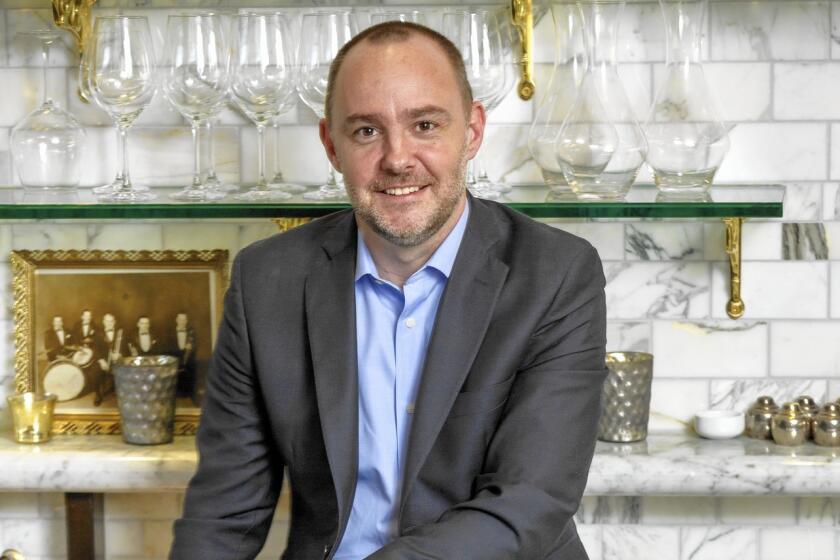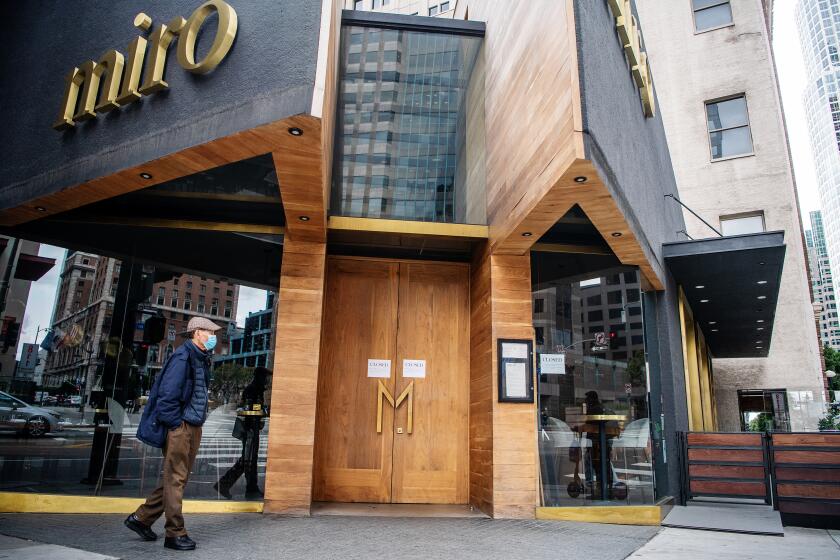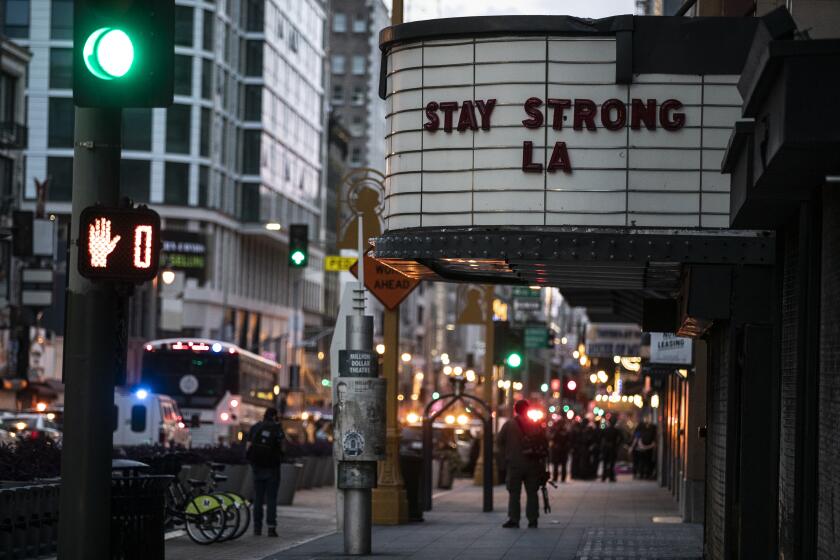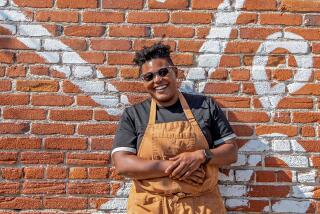Face masks, shields and landing zones. How one L.A. restaurant reopened its dining room
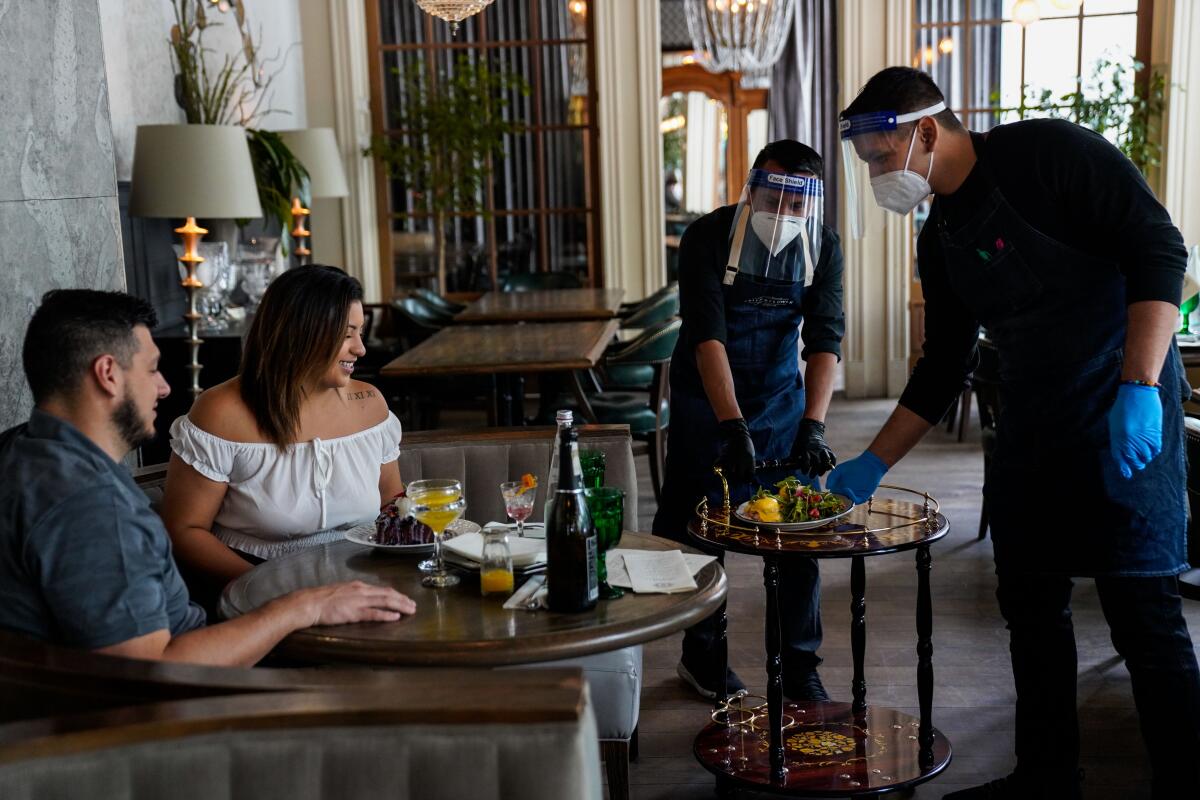
- Share via
“Landing zone” might sound more at home on an Air Force base, but at Faith & Flower restaurant in downtown L.A., there are now 17 of them.
On Saturday morning, about 90 minutes before the restaurant planned to reopen its doors for the first time since closing in mid-March, owner Stephane Bombet and his staff were busy setting up the special zones by adding an additional table to every two-person table and placing an ornate bar cart next to each larger booth.
Plus Disneyland’s reopening plans and Grubhub’s new owner
After weeks of trying to figure out how to maintain physical distancing and minimize interaction between staff and customers in a post-coronavirus-shutdown world, Bombet created what he calls landing zones. Depending on your table, the landing zone is either an additional table affixed to the end of your seating area or a removable cart, on which servers drop table settings, drinks, food and your check. You are instructed to retrieve items once the server has stepped away and take care of setting your own table and pouring water. When you want something to be cleared, you place it back on the landing zone for removal.
“It’s going to be hard,” Bombet said. “You’re not allowed to present things to the table and hover over customers. A landing zone is our idea to make it safer and easier.”
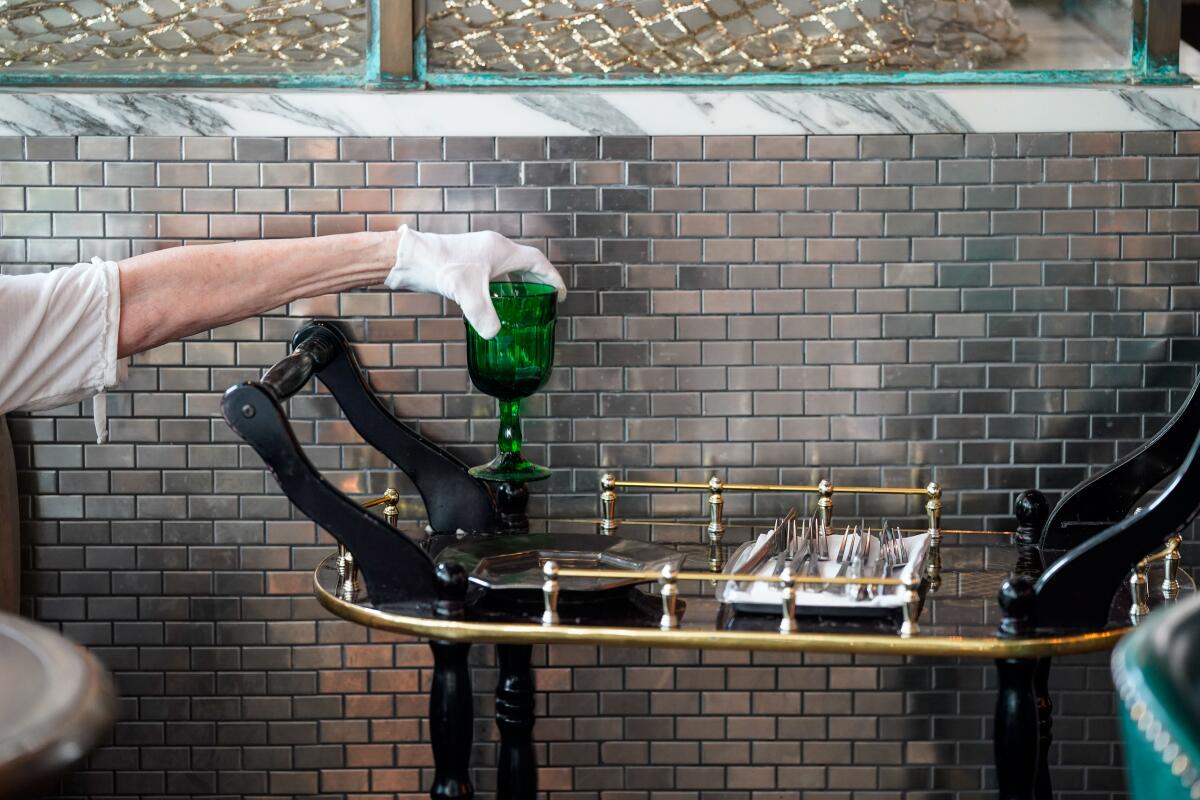
Morning supervisor Conor Susi walked through the dining room and dropped a folded piece of paper on each table. On it was information on the landing zone, how to use it and other safety precautions including a request to order your drinks, food and dessert all at the start of your meal.
General Manager Anthony Dougherty checked the reservation system, which showed a total of 35 covers for brunch; typically the 7,000-square-foot restaurant would have 320 covers. Instead of a half-empty dining room, Bombet chose to keep the table layout mostly intact but seat only half the tables at a time, both inside and on the patio, to maintain social distancing.
“We’ve been working six hours a day for the last week training the team,” Bombet said from behind a black face mask. He downloaded the 12-page Los Angeles County Department of Public Health protocols for reopening and has restructured almost every aspect of his once small-plates-driven, New American restaurant.
Seating 60% capacity and maintaining six feet of social distance is a total lie.
— Stephane Bombet, owner of Faith & Flower restaurant
If Bombet puts six feet between every seat, he calculated that he can use only 60 (38%) of his available 164 seats. That also means only three at the bar, which normally seats 17.
“This system is not meant to make money,” he said. “Our break-even is $10,000. Today, for the whole day, we might do $5,000.”
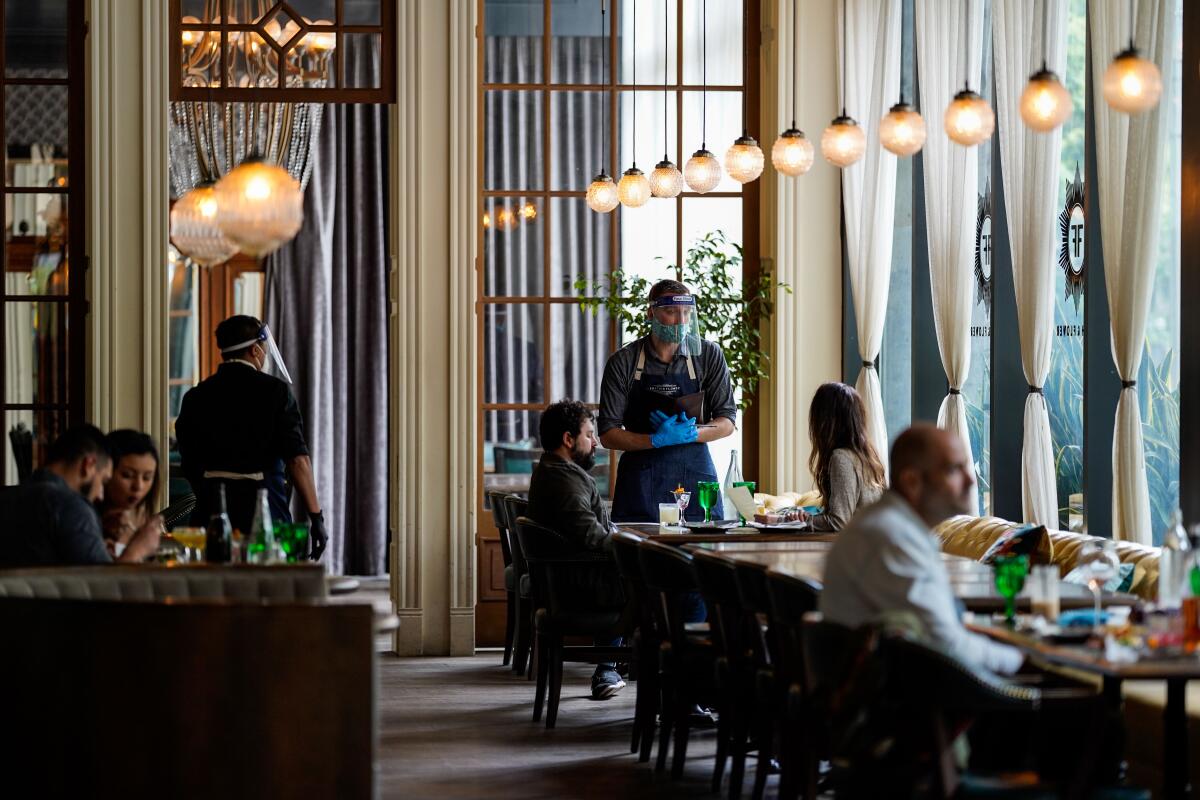
Bombet pays more than $30,000 a month for rent, plus more than $200,000 in payroll. He’s hoping the federal Paycheck Protection Program, introduced in April to help struggling small businesses during the mandated coronavirus shutdowns, will help offset some of his larger costs and allow him to at least break even.
Around 45 minutes before service, chef Michael Hung walked around the kitchen wearing a P95 mask and goggles, spraying surfaces with sanitizer. Red dots were stuck to the floor to show the cooks the parameters of their stations.
The new version of the Paycheck Protection Program loosens rules on how businesses can spend their money
Behind Hung, chef Ricardo Acevedo used an infrared thermometer to take another employee’s temperature and logged it on a piece of paper. Hung made his way into the dining room and sprayed all the door handles.
“I’m usually sleeping at this time,” he said. Then he started to trim disposable paper menus for service.
In preparation for reopening, Hung reduced the menu of 36 dishes by one third and streamlined production to accommodate fewer people in the kitchen. He removed all raw bar and tartare dishes and ditched microgreens and flower garnishes. With only one dishwasher, Hung adjusted recipes so that more items could be cooked in one pot or pan.
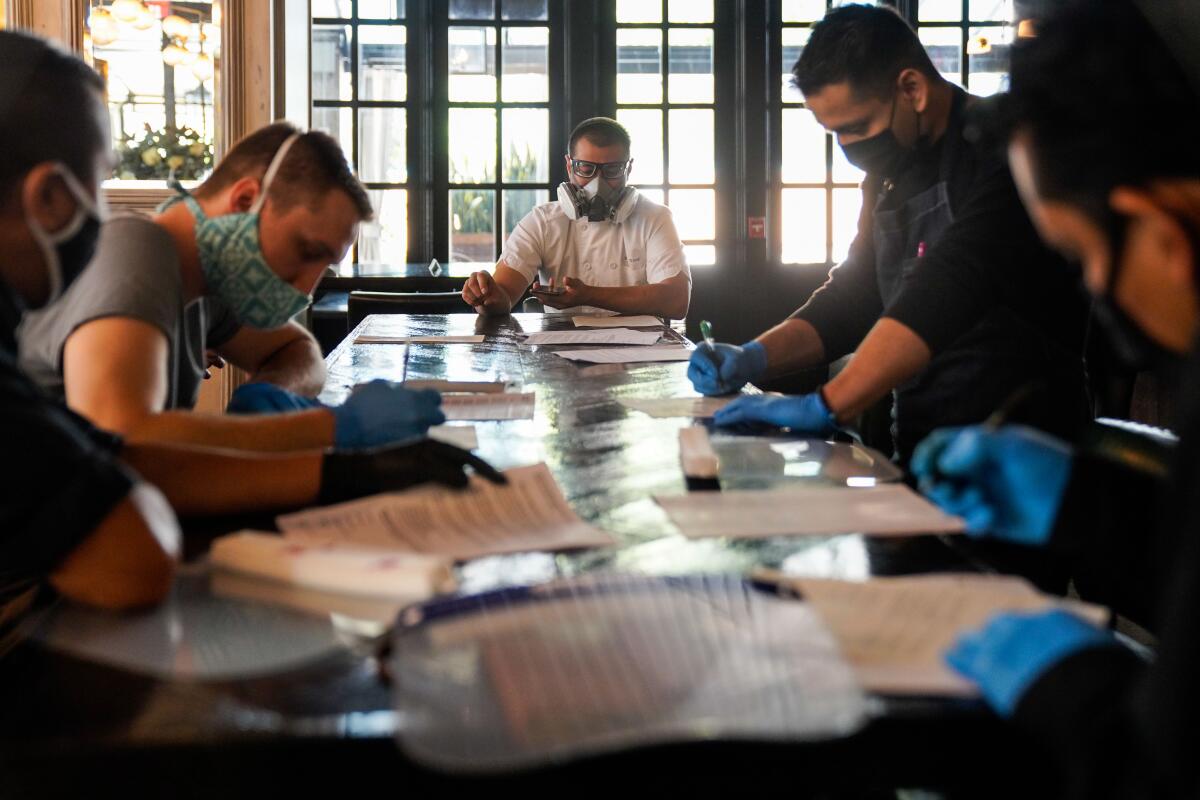
“I’m excited to reopen the dining room but at the same time, I’m also concerned about protecting my health because I have diabetes, and also protecting the health of my staff,” Hung said. “We can play with the food all we want two to three weeks down the line, but we just have to make sure we’re here in two or three weeks.”
Twenty-seven minutes before service, Bombet called the front of the house staff to the bar area for a pre-shift meeting.
A long table in the middle of the room, where groups of patrons used to stand shoulder to shoulder sipping $16 milk punches, was littered with copies of the health department protocols and a handful of face shields. Each employee, all wearing masks, grabbed a pamphlet.
“You’re going to see a lot of changes, so I don’t want you to go fast,” Bombet said to the small group before him. Besides the manager and supervisor, he had just one busser, one runner and two people working the bar. “We have to relearn a lot of things. We’re going to do it right and take our time.”
Anthony Suggs grew up in Long Beach. He was sentenced to prison for a nonviolent marijuana offense and released when pot was legalized. He’s been trying to get his life back on track by opening a food truck, Antidote Eats.
“Every station has hand sanitizer, paper towels and gloves,” Hung said. “You should be changing gloves between every table you service, washing your hands and sanitizing. We are running a timer so every hour we stop, sanitize, wash hands, then change gloves.”
Bombet estimates he spent an additional $10,000 on cleaning and personal protective equipment such as gloves, face shields and masks, to reopen the dining room.
When the meeting was over, each employee grabbed a face shield.
At 10:29 a.m., the first table arrived. It was a group of four friends that included Vartan Abgaryan, the chef at Yours Truly in Venice. Abgaryan, whose restaurant dining room remains closed, said he came in because he was curious about how Bombet was operating.
About 10 minutes later, the second guest arrived. A steady trickle of diners continued until a dozen people were in the dining room, spaced out at four tables.
“I’m terribly thrilled to be back,” said Virginia Elwood-Akers, 81, who dined by herself at one of the booths by the window. After reading the landing zone instructions on her table, she slid the piece of paper into her purse. “I’m taking it to show people so they won’t be afraid to come out and eat,” she said.
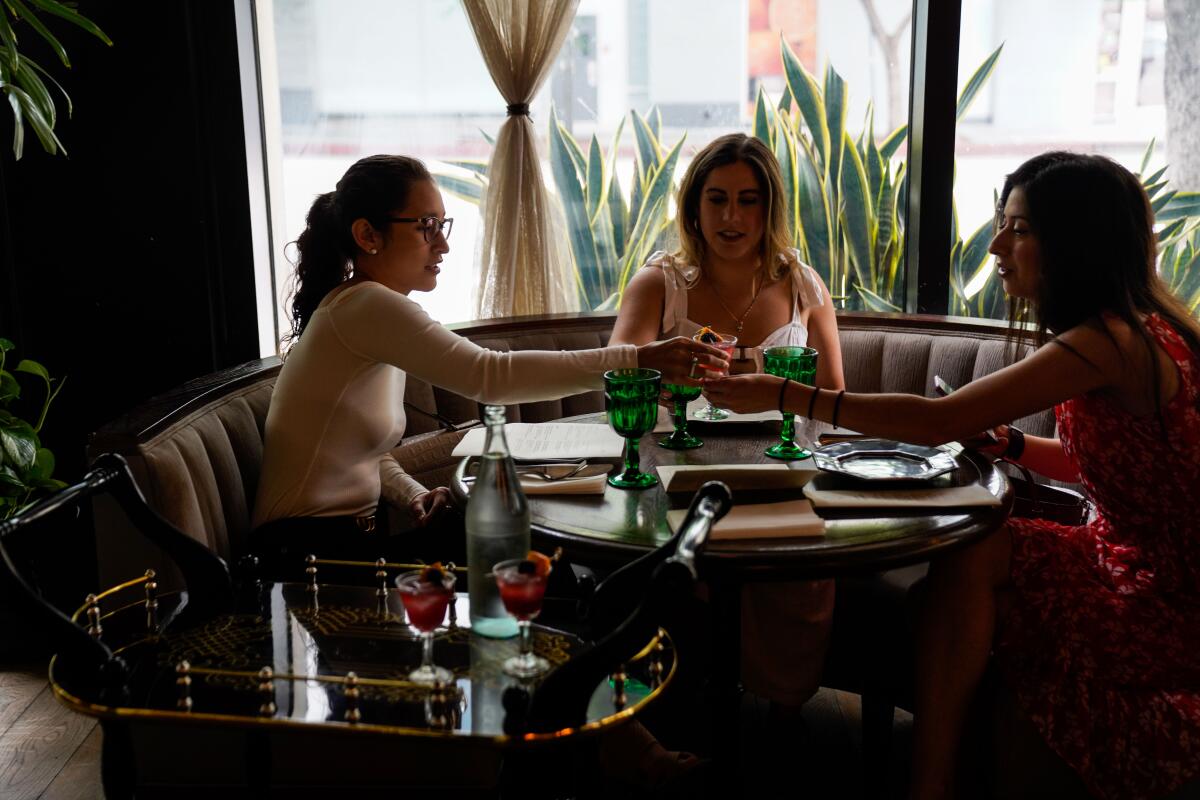
One table over, co-workers Alejandra Lizarzaburu, 26, Stephanie Krakower, 24, and Dianna Barba, 27, sat down for brunch. They hoisted their cocktails up to toast to the end of the week.
Krakower said she liked the landing zone idea and the look of the bar cart, with its glossy black surface and elegant gold trim.
“It’s very cool and creative that this restaurant found a way to do it where it’s still cute and fits with the ambience,” she said.
At noon, a couple without a reservation approached the door and asked for a table. Because the health department protocols suggest advance reservations for diners, Bombet implemented a reservation-only model using OpenTable. As walk-ins arrived, he explained the situation and told them they could use the app to make a reservation on the spot if there was one available. Some shook their heads and went looking for brunch elsewhere.
Chefs are using social media to advocate beyond their restaurants, speaking out against racial injustice.
“It’s very hard to say no to customers, but by reopening, we committed to doing it this way,” Bombet said. “How often do you say no to a customer that comes to your restaurant? And an empty restaurant?”
At 12:22 p.m., a reservation called to say they were worried about getting stuck in the protests downtown and were no longer coming.

Customers are required to input credit card information when they make a reservation, but Bombet said he won’t charge anyone who doesn’t show up or cancels.
“There are already so many layers of heavy rules,” he said. “If last-minute they get cold feet, we are not going to charge them.”
Shortly after, another couple without a reservation arrived. Bombet showed them how to use OpenTable to book the table that just opened, then sat them for brunch. He was able to book two more reservations on the spot and a couple more filled up online before the end of service.
After a total of 58 covers, the skeleton staff closed at 2:30 p.m. to clean, sanitize and attempt the new normal all over again for dinner at 5 p.m.
“How long will this last?” Bombet said. “I’m hoping one to two months. We’re just going to open and hope for the best.”
More to Read
Eat your way across L.A.
Get our weekly Tasting Notes newsletter for reviews, news and more.
You may occasionally receive promotional content from the Los Angeles Times.
